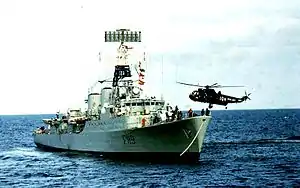HMS Eskimo (F119)
HMS Eskimo was a Tribal-class frigate of the Royal Navy in service from 1963 to 1980. She was scrapped in 1992.
 | |
| History | |
|---|---|
| Name | HMS Eskimo |
| Operator | Royal Navy |
| Builder | J. Samuel White |
| Laid down | 22 October 1958 |
| Launched | 20 March 1961 |
| Commissioned | 21 February 1963 |
| Decommissioned | August 1980 |
| Identification | F 119 |
| Motto |
|
| Fate | Scrapped in 1992 |
| General characteristics | |
| Class and type | Tribal-class frigate |
| Displacement |
|
| Length | |
| Beam | 42 ft 3 in (12.88 m) |
| Draught |
|
| Propulsion |
|
| Speed | 27 knots (50 km/h; 31 mph) (COSAG) |
| Range | 4,500 nautical miles (8,300 km; 5,200 mi) at 12 knots (22 km/h; 14 mph) |
| Complement | 253 |
| Sensors and processing systems | |
| Armament |
|
| Aircraft carried | 1 × Westland Wasp helicopter |
Eskimo was built by J. Samuel White, of Cowes,[2] at a cost of £4,670,000.[3] The frigate was launched on 20 March 1961 and commissioned on 21 February 1963 with the pennant number F119.[2]
Service
'Eskimo' began her third commission in October 1966. Sailing from Portsmouth in May 1967, she arrived off Port Said on the morning of 5 June, but due to the outbreak of war between Israel and the surrounding Arab states (the six day war), she was unable to transit the Suez Canal as planned. ‘Eskimo’ then spent some three months in the Mediterranean (based primarily in Malta) before eventually sailing to the Middle East via Gibraltar, Simonstown (South Africa), two Beira patrols, and Mombasa, arriving on station in Bahrain in December of that year. She subsequently replaced her sister ship Ashanti off Aden in 1968 in support of the withdrawal of British troops from that colony. ‘Eskimo’ finally returned to the UK in May 1968 having spent a full twelve months away from home. Later in the year she took part in Portsmouth 'Navy Days'.[4] Between 1966 and 1967 she was commanded by Simon Cassels.
During 1974 and 1975 she was commanded by Alan Grose.
Due to a manpower shortage in the Royal Navy,[5] Eskimo was reduced to the reserve in 1980, being placed into the Standby Squadron, and in 1981 was put on the disposal list.[6] In 1984 she was cannibalised for spare parts for three Tribal-class frigates sold to Indonesia. On 16 January 1986, Eskimo was towed from Portsmouth to Pembroke Dock to be used as a target, but was not used as such.[7] In May 1992 she was towed from Pembroke to Bilbao, Spain to be scrapped.[8]
References
- Blackman 1971, p. 356.
- Gardiner, Robert & Chesneau, Roger (1995). p. 518
- "News in Brief". The Times (55970): Col B, p. 6. 26 March 1964
- Programme, Navy Days at Portsmouth August 31st-September 2nd 1968, p. 19.
- "Armed Forces Manpower (1979)". Parliamentary Debates (Hansard). Written-Answers. 28 June 1979. Retrieved 13 March 2012.
- "Standby Squadron (1982)". Parliamentary Debates (Hansard). Written-Answers. 26 April 1982. Retrieved 13 March 2012.
- "HMS Eskimo F119". helis.com. Retrieved 16 March 2020.
- http://www.shipstamps.co.uk/forum/viewtopic.php?f=2&t=8257 shipstamps.co.uk: HMS Eskimo
Publications
- Blackman, Raymond V.B. Jane's Fighting Ships 1971–72. London: Sampson Low, Marston & Co, 1971. ISBN 0 354 00096 9.
- Colledge, J. J.; Warlow, Ben (2006) [1969]. Ships of the Royal Navy: The Complete Record of all Fighting Ships of the Royal Navy (Rev. ed.). London: Chatham Publishing. ISBN 978-1-86176-281-8.
- Gardiner, Robert & Chesneau, Roger (1995), Conway's All the World's Fighting Ships 1947-1995, Conway Maritime Press, London, ISBN 978-0-8517-7605-7.
- Marriott, Leo, 1983. Royal Navy Frigates 1945-1983, Ian Allan Ltd. ISBN 07110 1322 5